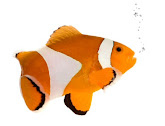Aquariums – Biological Filtration
In the aquarium fish world, there are three types of filtration for your tank -- Mechanical, chemical, and biological. A mechanical filter deals with removing particles from the water, while chemical involves exactly what you’d think, using chemicals like carbon to clean, polish, and filter the water. The third type of filtration, biological, is a bit more complex. Biological filtration essentially makes toxic ammonia non-toxic in what is referred to as the nitrogen cycle. In your enclosed aquarium environment, waste materials, including decaying uneaten food and fish excretions, build up and turn into ammonia. This ammonia is harmful and potentially lethal to your fish. In order for the ammonia to be removed from the aquarium, the nitrogen cycle must take place. When the ammonia levels in your aquarium reach a certain level, “good” bacteria from the air settles in the water and starts to form colonies in your filter or rocks. These bacteria convert the ammonia to nitrite. At this time the ammonia levels drop to low levels and the nitrite levels starts to increase. The nitrites in the water are also toxic to fish. When the nitrite level in the water has reached suitable levels another type of “good” bacteria starts to establish colonies in your aquarium. These bacteria convert the nitrites to nitrates, which are less harmful in small quantities and is absorbed by plants or algae. Since the “good” bacteria occur naturally, in order for their growth to occur, all that is required is ammonia and oxygenated water. This is the beginning of the nitrogen process and the growth of bacterial colonies.A biological filter, therefore, usually contains some type of surface area which promotes the growth of these “good” bacteria. Since you need oxygen and a lot of surface area for bacterial colonies, wet/dry filters, sponge filters, ceramic media, and loosely packed upper layers of gravel are all sources for bacterial accumulation. If there is not adequate surface area in oxygen areas of the filter media or gravel, the nitrogen cycle may not occur fast enough to convert the ammonia.



